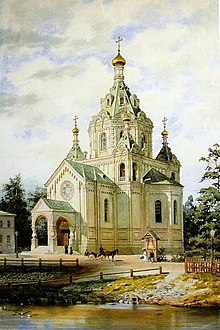Alexander Krakow
Georg Alexander Ivanovich Krakow ( Russian Александр Иванович Кракау ; born April 8 jul. / 20th April 1817 greg. In St. Petersburg , † April 12 jul. / 24. April 1888 greg. ) Was a Russian architect of German origin and University professor .
Life
Krakow's father Johann-Georg Krakau came from Krakow am See and settled in St. Petersburg at the end of the 18th century. Krakow attended the German Lutheran Petri School from 1825 to 1832 . Then he studied at the Imperial Academy of Arts (IACh) in Konstantin Thon's class. In 1839 Krakow graduated with the Great Gold Medal, which was accompanied by a scholarship for subsequent studies abroad. However, he first had to work with Konstantin Thon in the drawing commission for the construction of the Cathedral of Christ the Savior in Moscow .
In 1842 Krakow traveled to Italy to study architectural monuments and participated in the work of his fellow students Alexander Resanow and Nikolai Benois to restore the Orvieto Cathedral . When Krakow returned to St. Petersburg in 1850, he was given the title of Academic of Architecture and became a state architect in the Imperial Drawing Cabinet . In 1853 he was appointed professor of architecture with the project for a Greek- Russian church.
In 1854 Kraków became the senior architect of the First Transport Circle Administration. In this position he realized one of his most famous building projects from 1855 to 1857, the Baltic Railway Station in St. Petersburg, which was financed by Baron Alexander von Stieglitz . A villa was also built for von Stieglitz (1859–1863). This was followed by the main telegraph office (1859–1861), Krakow's tenement house (1865–1866), in which he lived, and the Church of St. Nicholas of Myra (1866–1871, not preserved).
From 1867 until his death Krakow taught architecture in the classes of the IACh, with the focus on the style of the Italian High Renaissance .
From 1878–1881, Cracow and Robert Gödicke built the St. Petersburg Central School for Technical Drawing for Baron von Stieglitz. He also built a dacha for Baron von Stieglitz on St. Petersburg's Kamenny Island and the Stieglitz Church of the Holy Sepulcher in Narva . His buildings identified him as a representative of eclecticism .
Krakow was awarded the Russian Order of Saint Stanislaus for its special services to architecture . In 1882 he was appointed privy councilor (third class ). In 1885 he received a hereditary title of nobility .
Cracow had two sons, the electrochemist Alexander Alexandrowitsch Cracow and the director of the St. Petersburg Karl-Iwanowitsch-May-Gymnasium Wassili Alexandrowitsch Cracow (1857-1934).
After Krakow's death, the funeral service took place at his request in the St. Petersburg Lutheran St. Peter's Church with burial in the Smolensk cemetery in the Lutheran department.
Web links
Individual evidence
- ↑ a b c d e f g Александр Иванович Кракау (accessed September 6, 2017).
- ↑ a b c Б.К. Виноградов: Василий Александрович Кракау (accessed September 6, 2017).
- ↑ В. Г. Исаченко: Зодчие Санкт-Петербурга. XIX– начало XX века . Лениздат, St. Petersburg 1998, ISBN 5-289-01586-8 .
| personal data | |
|---|---|
| SURNAME | Krakow, Alexander |
| ALTERNATIVE NAMES | Krakow, Georg Alexander Iwanowitsch (full name); Кракау, Александр Иванович (Russian) |
| BRIEF DESCRIPTION | Russian architect and university professor |
| DATE OF BIRTH | April 20, 1817 |
| PLACE OF BIRTH | St. Petersburg |
| DATE OF DEATH | April 24, 1888 |
| Place of death | St. Petersburg |



